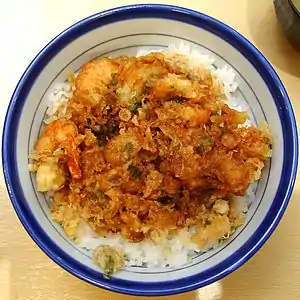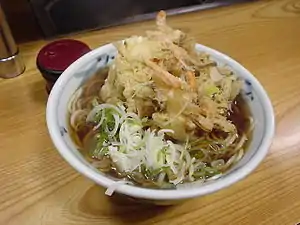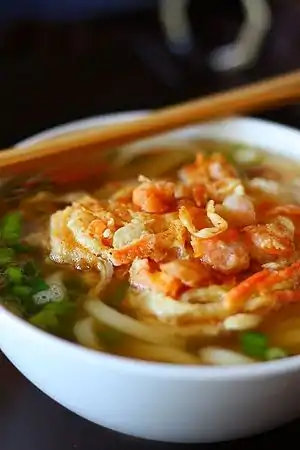Kakiage
Kakiage or kaki-age (かき揚げ, 掻き揚げ or かきあげ), a Japanese dish, is a type of tempura. It is made by batter-dipping and deep-frying a batch of ingredients such as shrimp bits (or a clump of small-sized shrimp). Kakiage may use other seafood such as small scallops, shredded vegetables or a combination of such ingredients.
 Kaki age don (kaki age tendon) | |
General description


Kakiage is a type of tempura that uses small pieces of seafood, or vegetable or both.
Sometimes the main ingredients are clumps of fish or shellfish that are individually small,[1] or chopped into small pieces.[2]
The variety of seafood used include shrimp, mollusks like scallop,[2] or fish,[3][1] and can be combined with vegetables such as onion or mitsuba.[4] The kakiage may also use vegetarian ingredients such as carrots, burdock, or onions chopped into matchsticks[5][6] or into bits.[1]
Preparation
The lump being fried is shaped into disks,[lower-alpha 1][6] and the kakiage are sometimes described as a "pancake" of sorts.[2] It is also referred to as a type of "fritter".[7][8]
The recipe may call for gently sliding the dollop of battered ingredients into hot oil,[6] and since it may try to break apart, a spatula may be used to hold it into place until the shape has set.[9] There is a modern-day implement being sold called a kakiage ring to assist in its cooking—a cylindrical, perforated sheet metal mold on a handle.[10]
In traditional preparation, these small pieces breaking apart must be constantly "raked together" (Japanese: kakiageru (掻き上げる)).[11]
Serving options
Kakiage maybe eaten with tentsuyu or tempura dipping sauce and grated daikon radishes,[8] or with seasoned salt,[9] just like any other type of tempura.
It may also be served as a kakiage donburi or kakiage don, which is a rice bowl dish with a piece of kakiage placed on top of steamed rice.[12][7] A tendon (tempura bowl) may also include a piece of kakiage among other tempura morsels.[13]
Kakiage may top a bowl of kakesoba (hot soba in broth) or udon.[7]
Ingredients used in Japan
The kakiage typically uses a type of shrimp called shiba ebi (Metapenaeus spp.), whereas the individual whole shrimp tempura commonly uses both the shiba ebi and saimaki ebi (juvenile kuruma ebi).[14][15]
Another standard is using a type of small "scallops" called kobashira which are actually the adductor muscles of the bakagai or aoyagi clams (Mactra chinensis).[16][11]
Kakiage using fresh sakura shrimp are usually offered in the vicinity of Suruga Bay, Shizuoka Prefecture where these are caught,[17] although some recipes may call for the dried sakura shirmp which are more widely available.[18]
Etymology
The kakiage is so-named because one "mixes up" kakimazeru (かき混ぜる) the ingredients before they are fried, or so it has been claimed, e.g., by the tempura chef and proprietor of Tenkichi in Yokohama.[19]
Scholar Ikeda Yasaburō also introduces the same etymology, anecdotally quoting another tempura chef.[lower-alpha 2][20]
History
Morisada mankō (written 1837–1853) stated that the tempura offered at soba noodle shops at the time used shiba ebi shrimp,[21] and according to a soba researcher, tempura soba was invented around the Bunsei era (1818–1830), using the shiba ebi shrimp kakiage as topping.[22][23]
Ex-shogun Tokugawa Yoshinobu became a regular customer at the tempura restaurant Tenkin, where he would order a specially large size kakiage to be served on a Nabeshima ware plate.[24]
See also
Explanatory notes
- Rather than into balls or other shapes.
- This chef was lecturing to a customer that the kakiage he ordered was not deep-fried kaki, which would be kaki furai.
Citations
Footnotes
- Hosking, Richard (2015). "kakiage". A Dictionary of Japanese Food: Ingredients & Culture. C.N. Potter. p. 64. ISBN 9781462903436.
- Kondo, Sonoko; Stoumen, Louis Clyde (1986). The Poetical Pursuit of Food: Japanese Recipes for American Cooks. C.N. Potter. p. 174. ISBN 9780517556535.
- Yamaguchi, Momoo; Kojima, Setsuko (1979). "kaki-age". A Cultural Dictionary of Japan. Japan Times. p. 95.
- Nabeko ナベコ (2019-03-18), "Tendon Tenya 'kakiage tendon' fukkatsu" 天丼てんや「かき揚げ天丼」復活, Shūkan Ascii
- Ono & Salat (2013), p. 124.
- Hashimoto (2016), p. 98.
- Ono & Salat (2013), p. 121.
- Hara, Luiz (2018). "Kakiage". The Japanese Larder: Bringing Japanese Ingredients into Your Everyday Cooking. Quarto Publishing. p. 192. ISBN 9781781318836.
- Matsuhisa, Nobu; Edwards, Mark (1986). Nobu West. C.N. Potter. p. 100. ISBN 9780740765476.
- Hirose, Takayo 広瀬敬代 (2017-02-14). "Hanahiraku onion ni shokunin-waza kakikage agemono senyō dōgu 4sen" 花開くオニオンに職人技かき揚げ 揚げ物専用道具4選 [From blooming onion to craftsman skill kakiage: selection of 4 deep-frying tools]. Nikkei.
- Sasakawa, Rinpū 笹川臨風 (1965). "19 Mikaku sōmakuri 味覺總まくり". Meiji sukigaeshi 明治還魂紙. Meiji bungaku kaikorokushū. Chikuma Shobo. p. 160.
- Hashimoto (2016), p. 117.
- Snyder, Garrett (2012-09-18). "46: Edomae Tendon Bowl at Hannosuke". LA Weekly.
- Hosking (2015), p. 37.
- Okuyama (1972), p. 259:"シバエビ..クルマエビより味はやや落ちるが、付け焼き、煮もの、てんぶらのかき揚げ、酢の物など、利用法は多い (Shiba ebi.. slightly less tasty than kuruma ebi, but is marinade-broiled, braised, made into kakiage tenpura, etc., there are many uses)"; p. 119: "エビ.. シバエビは.. てんぷらに向く。クルマエビの小さいのをサイマキといい、てんぷら用 (ebi [shrimp].. shiba ebi.. is suited for tempura.. small-sized kuruma ebi is called saimaki and used for tenpura)".
- Tada, Tetsunosuke 多田鉄之助 (1985). "kakiage" かき揚げ. Nihon daihyakka zensho 日本大百科全書. 4. Shogakukan. p. 876.
- Noguchi, Takuro; Miyasako, Junko (2018-12-14). "Shrimp fishing season scrapped amid depletion in Suruga Bay". Asahi Shimbun.
- Itoh, Makiko (2013-05-24). "Springtime beans aim for the sky". Japan Times.
- Hara, Shigeo 原成男 (2005). Sake to namida to tenpura: Yokohama kōjitsu Tenkichi biyori 酒と涙と男と天ぷら 横濱好日・天吉日和. Kanagawa Shinbunsha. p. 160. ISBN 9784876453689.
- Ikeda, Yasaburō 池田弥三郎 (1965-07-20). Watashi no shokumotsushi 私の食物誌. Kawade Shobo. p. 179.; reprint, Shinchōsha, 1980, p. 244.
- Kitagawa, Kisō 喜田川季荘 (1908), Muromatsu, Iwao 室松岩雄 (ed.), Ruijū kinsei fūzokushi: genmei Morisada mankōi 類聚近世風俗志 : 原名守貞漫稿, 2, Kokugakuin Daigaku Shuppanbu, p. 429
- Niijima, Shigeru 新島繁 (1975), 蕎麦入門, 保育社, p. 115, ISBN 9784586503438
- Iso, Naomichi 磯直道 (2006), Edo no haikai ni miru gyoshoku bunka 江戸の俳諧にみる魚食文化, Seizando shoten, p. 104
- Ikeda, Yasaburō 池田弥三郎 (1965-05-25). Ginza jūnishō 銀座十二章. Asahi Shimbunsha. p. 54.; also quoted in Arisue Ken et al., Toshi no katsuryoku 都市の活力, 2, p. 603.
Bibliography
| Wikimedia Commons has media related to Kakiage. |
- Hashimoto, Reiko (2016). Hashi: A Japanese Cookery Course. Bloomsbury Publishing. pp. 98, 117. ISBN 9781472933133.
- Okuyama, Masuaki 奧山益朗 (1972). Mikaku jiten 味覚辞典 (snippet). Tokyodo Shuppan. p. 141.
- Ono, Tadashi; Salat, Harris (2013). Japanese Soul Cooking: Ramen, Tonkatsu, Tempura, and More from the Streets and Kitchens of Tokyo and Beyond. Ten Speed Press. pp. 121–124. ISBN 9781607743521.
